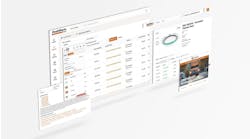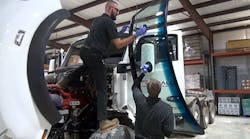Lift equipment can be puzzling to well-qualified buyers due to the array of options available. Considering the size of different lifts, whether they're mobile or fixed, it's essential that buyers get the best bang for their buck— and buying the right lift is not like picking out a wrench.
"[Mobile] distributors don't generally take lifts on the truck to demonstrate," said Steve Perlstein, a 27-year sales and marketing veteran at Mohawk Lifts. "But distributors can walk into a perspective customer's shop with a column cross-section, roller bearings, plastic side locks or a piece of chrome rod." This demonstrates the quality differences in lifts, and can help make the sale.
With upwards of 5,000lbs. suspended overhead, lifts are among the largest and most important pieces of equipment a shop owner can buy.
Certification counts
OSHA standards for lifts are understandably high and increasingly stringent. Organizations like The American National Standards Institute and the Automotive Lift Institute are in place to promote safety in the design, construction, installation and use of automotive lifts.
After OSHA and ANSI standards are met, certification must be obtained for lift equipment. Forty-three states require that lifts be certified by ALI and Intertek Testing Services. According to Perlstein, New York state building code requires that lift equipment be certified. In Oregon, if a distributor sells a non-certified lift, he can be fined with the possibility of having his license suspended the second time around.
Certified lift equipment is periodically checked to ensure that standards are continually being met. ALI contracts with Intertek to fully manage certification programs for lift equipment.
Mobile or Installed?
Aside from choosing a quality product, owners must also grapple with deciding which type of model is right for their shop. From standard two-post lifts to mobile wheel-engaging lifts for heavy duty trucks, shop size and vehicle demographic all need consideration. Knowing your customers and individual operations will help you target what lifts are needed where.
For stationary equipment, a shop must choose between in-ground and surface-mounted lifts. According to ALI, until the 1980s most lifts were in-ground. Although in-ground lifts are manufactured to suit almost any type of vehicle and undercarriage service, today's surface-mounted lifts make up a large part of the total number of lifts in use. Bolted to garage floors, surface-mounted lifts are generally powered by an electric motor which operates either a hydraulic pump or, less often, a screw-type drive.
"Two-post is the bread and butter of the lift industry," said Perlstein. "Two-post systems represent 80 percent of all lifts sold in North America." On two-post models, the lift arms ride up each column and can be synchronized mechanically, hydraulically or electronically.
Mike Eaton, director of marketing for Challenger Lifts Inc., said that four-post lifts do well in independent shops and dealerships, as well as two-post and cassette lifts, because they are able to service a wide variety of vehicles.
Lifts in the Fast Lane
Staying true to innovation and consumer demand, the lift industry is finding ways to enhance equipment, from accessibility to efficiency. Features include weight gauges and "speed lane" ramps to the swing arms.
"The Speed Lane is a popular option," Perlstein said. "Rather than taking five or six minutes to position the swing arm, the Speed Lane allows vehicles to drive right on, leaving the undercarriage still accessible." Features like this save techs time.
More imports on the road today are translating into stricter standards for designated vehicle pickup points.
"Versymmetric Technology provides the means by which to lift both symmetrically and asymmetrically," Eaton said. "Users can pick up passenger cars, trucks and SUVs in one sweep on the same lift and in the same bay. The biggest benefit (with Versymmetric lifts) is the fact that you've got one lift that will lift a multitude of vehicles. When a car, truck or SUV comes into a service shop, you're going to be able to pull that vehicle onto a Versymmetric lift and work on it. That's return on investment right there.
"That means a huge selling point when techs are talking about lifting just about any type of vehicle with one lift," Eaton said.
Turning a Buck
The price range for lift equipment will depend on what capacity lifts users are seeking. Perlstein said that a 10,000lbs. above-ground two-post lift is at most $5,000 and at least $2,500 (or less if it is non-certified). For car dealers and larger operations who have multiple bays or are looking for premium equipment, prices can skyrocket up to $50,000.
"I think the first thing [mobile distributors] need to know is that they're buying from a credible company that stands behind their product." Eaton said. "Next, they need to know that [the company's] an active ALI member … with a national network of authorized distributors, installation and service groups. They need to know they're getting a one-stop shop — they're getting sales and service in one company."
Jim Dirksen, director of North American Sales for Rotary Lift, stressed the importance of good research when selling lift equipment. Distributors need to understand vehicle service from the smallest to the biggest details.
"Make sure there's a local service reputation for the company," Dirksen said. "The most expensive lift a shop will ever buy is the one that breaks, because it is not generating any revenue while it is down for repair. The lift is the most important tool in the shop. Without it, you can't access the and service the vehicle."
Sources:
Steve Perlstein, Mohawk Lifts, www.mohawklifts.com
Mike Eaton, Challenger Lifts, Inc., www.challengerlifts.com
Jim Dirksen, Rotary Lift, www.rotarylift.com



